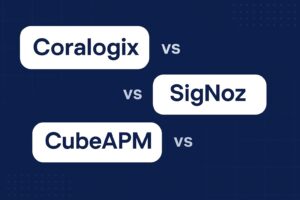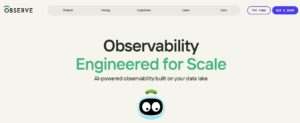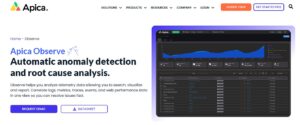Azure Monitor is Microsoft’s default observability suite for apps and infrastructure on Azure, offering APM, infra monitoring, log analytics, and alerting. However, it’s increasingly criticized for being fragmented, expensive, and hard to scale beyond Azure. With the APM market projected to hit $20.6B by 2030, teams are shifting to tools with predictable pricing, OpenTelemetry-native support, and full-stack visibility.
CubeAPM is the best alternative to Azure Monitor. CubeAPM is a modern observability platform purpose-built for cost-efficiency, compliance, and developer speed. Unlike Azure Monitor, it offers flat-based pricing $0.15/GB pricing across logs, traces, and metrics (no per-host or per-service fees), smart sampling, 800+ integrations, and native native support for OpenTelemetry.
In this article, we’ll explore the top Azure Monitor alternatives, comparing their feature sets, pricing, deployment models, and support quality. Whether you’re a startup trying to reduce observability spend, or an enterprise looking to break vendor lock-in, these options will help you choose a better APM stack.
Table of Contents
ToggleTools Comparison Table
| Tool | Telemetry Support (OTEL) | Deployment (Self-host, Setup) | Pricing | Sampling Strategy |
|---|---|---|---|---|
| CubeAPM | ✅ | Self-hosted, setup <1 hr | Ingestion-based pricing of $0.15/GB | Smart Sampling |
| Atatus | ✅(via Collector) | SaaS-only | APM: $0.07/host-hour per month, RUM: $1.96/10K views per month Logs: $2/GB/month Infra: $0.021 | OTel’s sampling |
| Datadog | Limited OTEL | Cloud-only, setup in 1–2 hours | APM: starts at $31/host/month; logs - $0.1/GB + $1.7/M events (15d) | Head-based |
| Dynatrace | Limited OTEL | Partial on-prem | $0.08/hour per 8 GiB host (~$57.60/host/month) | Davis AI |
| New Relic | Limited OTEL | Cloud-only, | Free tier: Ingestion based pricing of $0.35/GB + $400/user/month for full access | Head-based |
| Splunk AppDynamics | No | Enterprise on-prem | Starts $6/host/month, billed annually | Basic agent-level sampling only |
| HoneyComb | Native OTEL support | SaaS | Free & open-source platform; Enterprise support starts at ~$1,500/year | No built-in trace sampling |
| Grafana | ✅ | OSS self-hosted; Grafana Cloud optional | Free:✅,14 days retention; Pro: $19 / month + usage, 8X5 email support 13 months retention for metrics; 30 days retention for logs; Enterprise: $25,000 / year , Premium support, Custom retention | Sampling requires custom OTEL processor |
Top 7 Azure Monitor Alternatives
- CubeAPM
- Sentry
- Coralogiz
- Grafana
- Datadog
- Dynatrace
- New Relic
Why Look for Azure Monitor Alternatives?
1. Expensive and Confusing Pricing Tiers
Azure Monitor’s log pricing spans Auxiliary, Basic, and Analytics Logs—each with different capabilities and costs ranging from $0.05/GB to $2.30/GB, making budgeting and forecasting difficult for teams ingesting large volumes of telemetry data.
For example, one user said migrating from legacy to new Azure Monitor agents nearly quadrupled or quintupled their costs due to noisier data collection:
“I found the DNS logs using the Azure Monitoring Agent nearly tripled in cost for me over collecting DNS logs” (Reddit User)
Compared to CubeAPM, Azure monitor is almost 5 times the cost.
For example a mid-szied company ingesting 10TB/month, Azure Monitor often splits telemetry between Basic Logs (70%) at $0.50/GB and Analytics Logs (30%) at $2.30/GB. That totals $3,584 + $7,065 = $10,649/month. Even optimized, teams pay 5× more than CubeAPM—plus deal with hidden costs for queries, exports, and log processing.
In contrast, CubeAPM charges a flat $0.15/GB, totaling just $1,536/month ($0.15 × 10,240) for a mid-sized enterprise ingesting 10 TB/month (10,240 GB) . There are no extra fees for metrics, dashboards, alerts, or retention. Smart sampling reduces noise while preserving critical traces, and self-hosting avoids compliance or egress issues.
2. No Self-Hosted or Private Cloud Deployment
Azure Monitor is strictly SaaS-only, lacking options for on-premise or private-cloud deployment, which makes it unsuitable for compliance-sensitive, air-gapped, or localized deployments.
3. Steep Learning Curve
Azure Monitor’s interface spans multiple services—Application Insights, Log Analytics, Metrics Explorer, and Diagnostic Settings—each with different query languages, permissions, and settings. Setting up queries, alerts, and data pipelines often demands in-depth Azure expertise. Fine-tuning for cost and performance adds another layer of complexity, especially in multi-resource environments. Even experienced engineers face friction during onboarding or scaling.
As these users note:
“It takes a little bit to learn where things are, so it’s a learning curve.”(G2)
“I have noted a learning curve in configuring and fine-tuning Azure Monitor, especially for complex setups. Additionally, the cost structure can be challenging”(G2)
4. Complex UI and Disjointed User Experience
Azure Monitor’s user interface spans multiple portals and tools, making it hard to navigate and operate smoothly. Tasks like setting up alerts, viewing traces, or managing retention require jumping between Application Insights, Log Analytics, and other disconnected dashboards. This fragmented experience introduces a steep learning curve and slows down day-to-day workflows, especially for teams new to Azure.
As one user note:
“Its level of customization is good, but the interface can be overwhelming due to the number of options available; some of these could be merged into a single board to improve usability.” (G2)
5. Weak Native OpenTelemetry Support
Although OpenTelemetry is supported via Azure Monitor’s proprietary distro, this often still requires legacy SDKs and lacks advanced features like tail-based sampling and span enrichment.
5. Vendor Lock-In Risks
Because Azure Monitor is deeply integrated into the Azure ecosystem, migrating to multi-cloud or hybrid setups is cumbersome, resulting in risk of long-term vendor lock-in.
6. Lack of Real-Time Collaboration Features
Azure Monitor lacks native integrations with tools like Slack, PagerDuty, or Opsgenie for real-time alert routing. Incident response workflows often require manual setup or costly Azure Logic Apps, making it harder for SREs to collaborate during outages.
Criteria for Suggesting Azure Monitor Alternatives
1. OpenTelemetry-Native Instrumentation
We prioritize tools that offer first-class support for OpenTelemetry—not just compatibility layers. This ensures vendor-neutral data collection, better interoperability, and long-term observability flexibility.
2. Transparent and Predictable Pricing
The best alternatives offer simple, flat-rate pricing per GB of data or per host—without hidden costs for dashboards, queries, alerting, or retention. This avoids the budgeting headaches common with Azure Monitor’s tiered billing.
3. Full MELT Coverage (Metrics, Events, Logs, Traces)
Alternatives must support end-to-end observability, not just partial views. A modern platform should cover all four pillars (MELT) with correlation across them to speed up root cause analysis.
4. Self-Hosting or Private Cloud Deployment
For compliance-heavy or cost-sensitive teams, alternatives should offer on-prem or VPC-hosted deployment options. Azure Monitor’s SaaS-only model doesn’t meet data localization or air-gapped environment needs.
5. Smart Sampling and Retention Controls
Tools that use context-aware sampling (based on error rate, latency, etc.) help reduce ingestion volume while retaining meaningful telemetry. This leads to better cost-efficiency without losing visibility.
6. Unified User Experience
Unlike Azure Monitor’s fragmented UI, better alternatives provide a single-pane-of-glass interface where logs, traces, metrics, and alerts are accessible from one dashboard—cutting down operational overhead and onboarding time.
Azure Monitor Overview
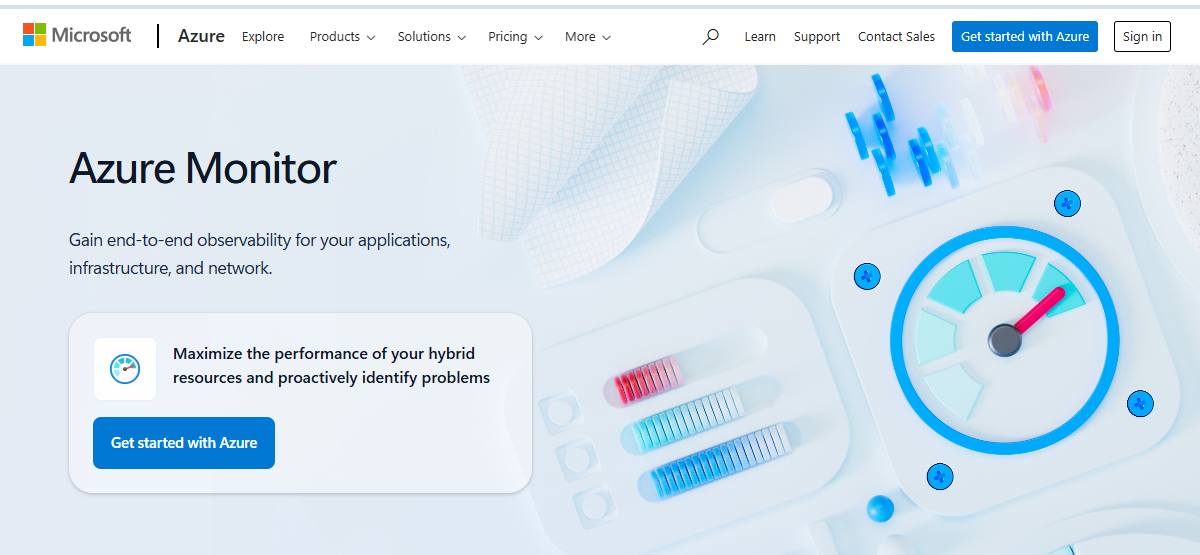
Known for:
Azure Monitor is Microsoft’s native observability suite, built for monitoring cloud applications and infrastructure within the Azure ecosystem. It’s widely used for performance monitoring, log analysis, metrics tracking, and diagnostics across Azure VMs, App Services, Functions, and Kubernetes clusters (AKS). It’s often the default choice for teams already committed to Azure.
Standout Features:
- Seamless integration with Azure resources (VMs, databases, services)
- Log Analytics with KQL (Kusto Query Language) for advanced querying
- Application Insights for APM, with telemetry from .NET, Java, Node.js, etc.
- Data Collection Rules (DCR) for managing what telemetry is sent
- Metrics Explorer for real-time charting across Azure services
- Availability/Synthetic testing via built-in tests
Key Features:
🔹 Application Performance Monitoring (APM)
Collects distributed traces, dependencies, and custom events through Application Insights.
However, OTEL support is still developing and often requires wrapping with legacy SDKs.
🔹 Log Analytics
Powerful querying engine via KQL, supports cross-table joins and summary rules.
Logs are separated into Basic, Analytics, and Auxiliary tiers—each priced and queried differently.
🔹 Infrastructure & Resource Monitoring
Native visibility into CPU, disk, memory, and network usage for Azure-native services.
Also supports AKS monitoring via Azure Monitor for containers.
🔹 Alerts & Dashboards
Supports threshold-based and dynamic alerts with Action Groups.
Can integrate with ITSM tools, email, SMS, and Logic Apps, though setup is complex.
🔹 RUM & Synthetics
Includes browser monitoring for front-end insights and basic synthetic tests.
Advanced canary testing features are limited compared to third-party tools.
Pros:
- Deep native integration with Azure platform resources
- Excellent for organizations that are fully Azure-native
- Powerful querying and aggregation using KQL
- Scalable ingestion with support for huge volumes of telemetry
Cons:
- SaaS-only deployment—no self-hosted/VPC option
- Complex pricing model with multiple log types and hidden costs
- Weak OpenTelemetry support (uses a proprietary OTEL distribution)
- Steep learning curve due to fragmented UI across services (Insights, Logs, Metrics, etc.)
Best for:
Organizations that are heavily invested in Azure, need tight integration with Microsoft services, and can manage the cost/complexity of Azure-native observability tooling.
Pricing & Customer Reviews:
- Log Ingestion (Analytics Logs): Up to $2.30/GB, with discount tiers reaching $1.57/GB
- Basic Logs: $0.50/GB
- Auxiliary Logs: $0.05/GB
- Log processing: Additional $0.10/GB
- Synthetic tests, metric exports, and retention extensions are billed separately
- Estimated cost for 10TB/month: ~$8,000 (blended logs + metrics + overhead)
On G2, Azure Monitor holds a 4.3/5 rating.
Top 7 Azure Monitor Alternatives
1. CubeAPM

Known for:
CubeAPM is best known for being a lightweight, OpenTelemetry-native APM platform that supports full-stack observability (MELT) with extremely low cost and self-hosted deployment options. It’s a top choice for teams needing data sovereignty, smart sampling, and simplified billing.
Key Features:
- Distributed Tracing: Contextual OTEL-native tracing with latency, error, and custom tags.
- Log Monitoring: Structured log ingestion with filtering, retention, and correlation to traces.
- Infrastructure Monitoring: Tracks CPU, memory, disk, and network metrics across services.
- RUM & Synthetic Monitoring: Capture front-end performance and simulate uptime checks.
- Error Tracking: Built-in error inbox for monitoring exceptions and crash rates.
Standout Features:
- Smart Sampling: Retains important traces using latency/error context instead of head-based random sampling.
- Self-Hosting: Deploy in your own VPC or on-prem for compliance and egress savings.
- Flat Pricing: $0.15/GB for all data types—logs, traces, metrics—with no per-host or per-service fees.
- Zero Vendor Lock-in: Full OTEL and Prometheus compatibility.
Pros:
- 60–80% cheaper than Azure Monitor and legacy APMs
- Large integrations ecosystem–800+ integrations
- Zero egress costs
- Instant onboarding with OTEL or Datadog/New Relic agents
- Unlimited retention when self-hosted
- Native support for OpenTelemetry and Prometheus
- Direct Slack/WhatsApp support with low TAT
Cons:
- Not suited for teams looking for off-prem solutions
- Strictly an observability platform and does not support cloud security management
Best for:
Engineering teams and startups needing full MELT observability at a low, predictable cost, with self-hosting or data localization requirements.
Pricing & Customer Reviews:
- Pricing: $0.15/GB flat (no host or user-based pricing)
- Self-hosted cost: zero egress + infra
- G2 rating: Not yet listed (early adoption phase), but pilot users report 60–70% cost savings
CubeAPM vs Azure Monitor:
Unlike Azure Monitor’s fragmented UI and unpredictable costs, CubeAPM delivers a unified, OTEL-native experience with flat pricing and no hidden extras. It avoids Azure’s SaaS lock-in by offering full VPC/on-prem deployment, making it ideal for compliance-focused teams or anyone trying to cut cloud observability bills by 5×.
2. Sentry

Known for:
Sentry is primarily known for error and performance monitoring across frontend and backend applications. It’s widely used by developers to identify crashes, latency issues, and user-impacting bugs in real time.
Key Features:
- Error Tracking: Real-time exception monitoring with stack traces, breadcrumbs, and contextual metadata.
- Performance Monitoring: Measures transaction duration, spans, and latency across web and mobile applications.
- Frontend + Backend Coverage: Supports JavaScript, Python, Node.js, .NET, Java, iOS, Android, and more.
- Release Health: Tracks deployment impact, error regressions, and slow user sessions.
- Alerts & Workflow Integration: Built-in alert rules, plus integrations with Slack, PagerDuty, Jira, and GitHub.
Standout Features:
- Source Map Integration: Deobfuscates minified code for frontend debugging.
- Session Replay: Visual playback of user interactions to help reproduce bugs.
- Contextual Tracing: Combines performance data with error logs for end-to-end diagnosis.
- Developer-Centric UX: Optimized for fast debugging and collaboration across teams.
Pros:
- Easy to set up with lightweight SDKs
- Powerful debugging experience for both frontend and backend
- Excellent GitOps and CI/CD integrations
- Clean, responsive UI built for developers
Cons:
- Not designed for full observability (no native infrastructure metrics or log aggregation)
- Limited OpenTelemetry support—APM tracing is vendor-specific
- Scaling can get expensive if used as primary APM at large volumes
- No self-hosted option for advanced features like Session Replay or advanced analytics
Best for:
Engineering teams focused on frontend and API performance and needing best-in-class error monitoring rather than full-stack observability.
Pricing & Customer Reviews:
- Pricing (2025):
- Team: $26/month
- Business: $80/month
- Enterprise: custom
- G2 Rating: 4.5/5 — praised for ease of use and issue visibility, though some users note missing logs, infra visibility, and rising cost at scale.
Sentry vs Azure Monitor:
While Azure Monitor provides full-stack observability across infrastructure and applications, its complexity often frustrates developers. Sentry is laser-focused on code-level debugging and frontend monitoring. It lacks Azure Monitor’s breadth but outshines in developer experience, traceability, and alerting for app issues—making it a better fit for dev-centric teams with shallow observability needs.
3. Coralogix

Known for:
Coralogix is known for its log-centric observability platform that emphasizes cost efficiency, real-time processing, and flexible data routing. It’s often chosen by engineering teams looking to ingest large volumes of logs, traces, and metrics without breaking their budget.
Key Features:
- Real-time log ingestion and parsing with structured queries
- Alerting and live tail for immediate troubleshooting
- Derived metrics and traces from log streams
- Support for OpenTelemetry, Prometheus, and custom pipelines
- Integration with CI/CD, cloud providers, and notification tools
Standout Features:
- TCO Optimizer: Routes logs and telemetry into different storage pipelines (frequent-search, compliance, monitoring) to reduce cost
- In-Stream Analytics: Processes and analyzes data before indexing, reducing query load and storage costs
- Customer-Owned Archive: Archived data is stored in the customer’s own cloud, enabling lower long-term costs
Pros:
- Strong cost control and flexibility in telemetry routing
- Real-time alerting and live debugging with live tail
- Scalable to high ingestion volumes without indexing everything
- Strong reputation for ML-driven anomaly detection and fast support
Cons:
- Initial setup can be complex due to pipeline configuration
- Pricing model may require tuning to fully optimize
- Lacks full-stack infrastructure metrics compared to some alternatives
Best for:
DevOps and platform teams needing cost-efficient log and trace analytics, with fine-grained control over data pipelines and support for compliance through customer-managed storage.
Pricing & Customer Reviews:
- Three-tier plans from ~$245.55/month, billed annually
- G2 Rating: 4.6/5, praising its powerful real-time features and cost management capabilities.
Coralogix vs Azure Monitor:
Coralogix gives teams more control over costs by processing data before storage and letting customers store archives in their own cloud. Azure Monitor, by contrast, charges per-GB for ingestion and retention, often leading to surprise costs. Coralogix also supports data localization and egress reduction, while Azure Monitor remains a fully SaaS-only platform with more rigid pricing.
4. Grafana

Known for:
Grafana is best known for its visual dashboarding and alerting platform, widely used to monitor metrics, logs, and traces across cloud-native, on-prem, and hybrid environments. It’s favored by DevOps and SRE teams for real-time data visualization and integrations with Prometheus, Loki, Tempo, and other observability backends.
Key Features:
- Dashboard Builder: Custom time-series visualizations, variables, annotations, and templating
- Metrics Monitoring: Integrates with Prometheus, Graphite, InfluxDB, and many others
- Log Aggregation: Via Grafana Loki, providing context-rich log queries with stream labels
- Tracing: Powered by Grafana Tempo, supporting OTEL, Jaeger, and Zipkin formats
- Alerting Engine: Unified alerts from logs, metrics, and traces with routing to Slack, PagerDuty, and email
- Correlations: “Explore” tab for side-by-side querying of logs and metrics
Standout Features:
- Plug-in Ecosystem: 100+ community and commercial data source plugins
- Grafana Cloud: Fully managed observability stack combining metrics (Prometheus), logs (Loki), and traces (Tempo)
- Grafana OnCall: Built-in on-call management with escalation policies and schedules
- Synthetic Monitoring: Basic uptime checks and API test capabilities for web services
Pros:
- Free and open source core
- Powerful dashboarding and flexible query engine
- Vendor-agnostic and widely integrable
- Can be fully self-hosted or consumed as SaaS (Grafana Cloud)
Cons:
- Logs and traces require setting up Loki and Tempo—adds operational overhead
- Alerting and RBAC features limited in OSS; richer in Grafana Cloud Pro
- Native full-stack correlation not as seamless as in dedicated APM platforms
- Can become expensive in cloud plans if not tuned (especially for high logs/trace volume)
Best for:
Teams looking for visual-first observability, DIY stack flexibility, or an OSS foundation that scales across logs, metrics, and traces with fine control over integrations and cost.
Pricing & Customer Reviews:
Grafana offers both OSS and SaaS models. Grafana Cloud pricing is tiered by usage:
- Pro: $19/month,
- Advanced: $299/month
- G2 Rating: 4.5/5 rating, praised for its UI and flexibility, with some complaints about plugin maintenance and steep learning curves for complex setups.
Grafana vs Azure Monitor:
Grafana offers greater flexibility and cost control, especially for teams wanting to self-host or run hybrid stacks. Azure Monitor, while deeply integrated with Azure, is SaaS-only and much more rigid in pricing. Grafana’s modular architecture allows teams to plug in Prometheus, Loki, and Tempo at their own pace—whereas Azure Monitor bundles everything into a multi-tiered system with ingestion-based pricing and limited OTEL support.
5. Datadog
Known for:
Datadog is widely known for its full-stack observability platform, combining APM, infrastructure metrics, logs, security monitoring, and more—all under a unified SaaS model. It’s a go-to tool for cloud-native engineering teams.
Key Features:
- APM with distributed tracing, flame graphs, and service maps
- Real User Monitoring and Synthetic Monitoring
- Logs ingestion and processing with correlation to traces
- Host-level and container-level infrastructure monitoring
- Dashboards, alerting, SLOs, and incident workflows
Standout Features:
- Service Catalog: Central view of all services with health and owner metadata
- Watchdog: AI-powered automatic anomaly detection
- Integrations: 900+ native integrations with AWS, Azure, Kubernetes, and more
- Unified Agent: Single agent for metrics, logs, traces, and profiling
Pros:
- Excellent correlation between metrics, logs, and traces
- Mature alerting and dashboarding features
- Fast UI and rich out-of-the-box integrations
- Scalable for complex microservice architectures
Cons:
- Pricing is per-host, per-feature, and often scales poorly
- Smart sampling isn’t tail-based; noisy services drive up cost
- Limited flexibility for self-hosting or data residency control
- High TCO for teams with high-volume telemetry
Best for:
Teams with large microservice infrastructures needing deep correlation across logs, traces, and infra—but with the budget to absorb premium pricing.
Pricing & Customer Reviews:
- Pricing:
- APM: starts at $31/host/month
- logs – Effective Cost: $0.1/GB + $1.7/M events (15d), synthetics
- Infra Cost: starting at $15/host/month
Datadog vs Azure Monitor:
Datadog offers deeper visibility and correlation than Azure Monitor, especially for non-Azure environments. However, Azure Monitor is more cost-predictable in single-cloud Azure setups, while Datadog often becomes prohibitively expensive without careful data tuning.
6. Dynatrace
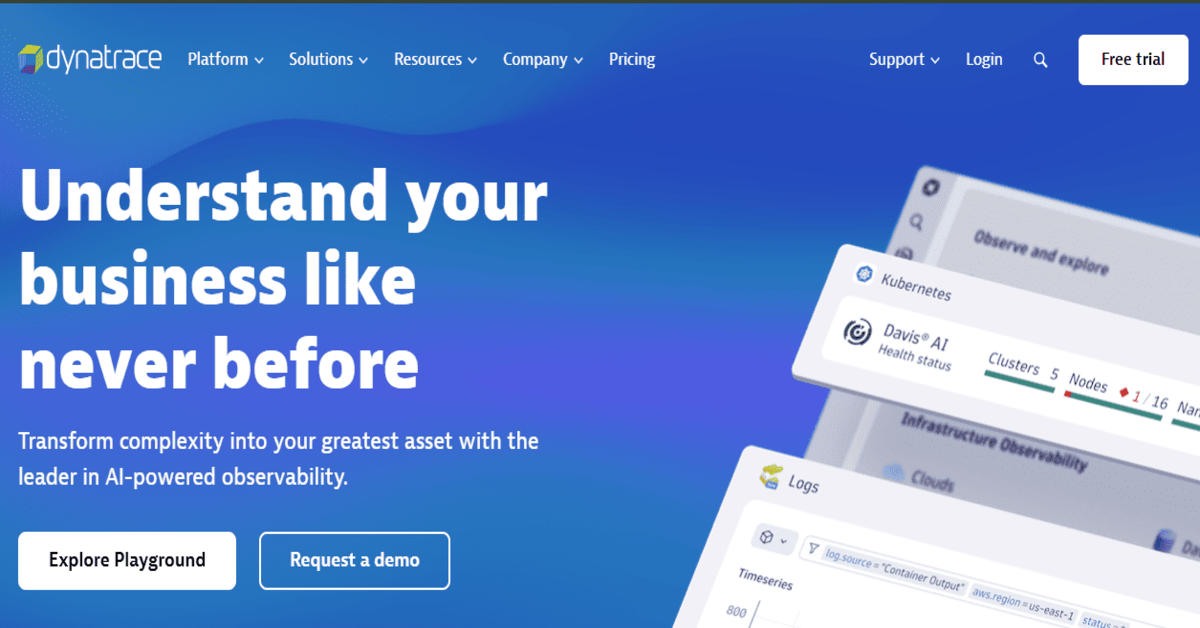
Known for:
Dynatrace is known for its AI-powered full-stack observability, with a heavy emphasis on automation, cloud infrastructure monitoring, and enterprise-scale environments.
Key Features:
- Distributed tracing and automatic instrumentation
- Logs and events ingested with trace-level correlation
- RUM, synthetic testing, and session replays
- Infrastructure + cloud workload monitoring
- Davis AI for anomaly detection and causal root cause analysis
Standout Features:
- Smartscape Topology: Real-time dependency maps of services, infra, and hosts
- Davis AI Engine: Built-in AIOps for auto-detecting and diagnosing issues
- Code-level Insights: CPU profiling, memory analysis, and service flow analysis
- Kubernetes & Cloud-native Focus: Auto-discovery of pods, containers, services
Pros:
- Rich, automated insights with minimal manual config
- Excellent scalability for large hybrid/multi-cloud deployments
- AI-based problem detection reduces alert fatigue
- High automation across setup, alerting, and updates
Cons:
- High learning curve and UI complexity
- Expensive licensing based on Davis Data Units (DDUs)
- Less flexible than OSS-based platforms for customization
- Limited control over infrastructure in SaaS mode
Best for:
Large enterprises needing automated observability at scale, especially across complex cloud-native environments or regulated industries.
Pricing & Customer Reviews:
Pricing: $0.08/hour per 8 GiB host (~$57.60/host/month)
G2 rating: 4.4/5, praised for automation and accuracy, with cost complexity noted as a barrier.
Dynatrace vs Azure Monitor:
Dynatrace offers more automation and intelligent root cause analysis, making it easier to reduce noise and resolve incidents faster. Azure Monitor, in contrast, requires more manual configuration and lacks Dynatrace’s AI-powered diagnostics—though it remains more accessible for smaller Azure-only teams.
7. New Relic
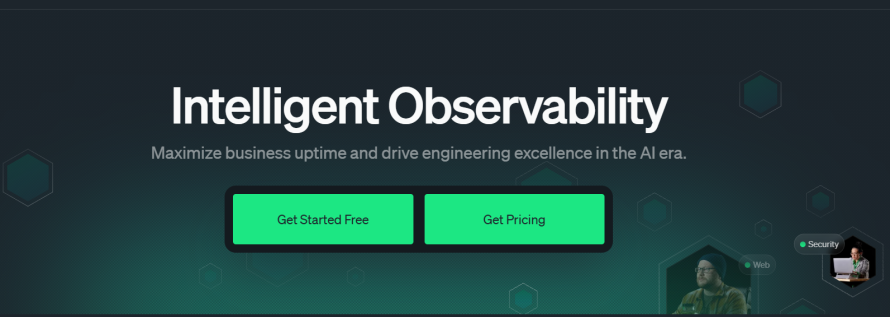
Known for:
New Relic is known for its telemetry platform with usage-based pricing, offering unified APM, logs, metrics, and traces with a strong developer UX.
Key Features:
- Distributed tracing, service maps, and transaction analysis
- Log ingestion, filtering, and correlation
- Infrastructure and network monitoring
- RUM, browser analytics, and mobile monitoring
- Alerts, dashboards, and SLO tracking
Standout Features:
- All-in-one Telemetry Data Platform: Logs, metrics, traces under one UI
- Query Language (NRQL): Powerful querying across all telemetry types
- Infinite Tracing: Scalable tail-based tracing
- CodeStream: Developer IDE integration for error insights inside code editors
Pros:
- Single pricing model for all observability types
- Simple instrumentation and auto-discovery
- Clean UI and fast learning curve
- Strong support for OpenTelemetry and cloud-native tools
Cons:
- Cost can spike with high-volume logs or traces
- SaaS-only deployment; no self-hosted option
- Limited customization for retention and routing logic
- Performance can lag in large-scale dashboards
Best for:
Developer-centric teams who want quick visibility into services and apps without needing deep infrastructure configuration.
Pricing & Customer Reviews:
Free tire available
New Relic charges $0.30/GB ingested, plus $49/user/month for full platform access.
G2 rating: 4.4/5
New Relic vs Azure Monitor:
New Relic offers simpler, usage-based pricing and a more unified UI than Azure Monitor. While Azure Monitor excels in native Azure integration, New Relic shines in developer usability, fast setup, and tail-based tracing—making it more appealing to modern engineering teams.
Conclusion
Azure Monitor remains a natural choice for teams already deep into the Azure ecosystem, offering native integration across Azure services. However, its complex pricing, fragmented user experience, and limited flexibility around deployment and OpenTelemetry support have pushed many organizations to explore more agile alternatives.
From CubeAPM’s flat-rate, OTEL-native stack, to tools like Datadog, Dynatrace, Coralogix, and Grafana, there are now mature observability platforms that deliver better control, cost-efficiency, and compliance. Whether your priority is real-time debugging, self-hosting, or smart sampling, this list provides strong alternatives to fit a range of team sizes, infrastructures, and compliance requirements.

